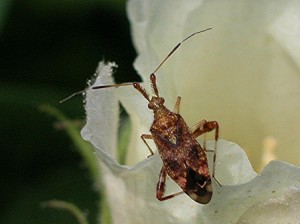
Plant bugs … I’d classify the overall plant bug pressure in cotton as average, although we are seeing a few more clouded plant bugs than in recent years. Until bolls are present, count tarnished and clouded plant bugs the same. Once bolls are present, I suggest counting clouded plant bugs as equivalent to 1.5 tarnished plant bugs when making a treatment decision, primarily because clouded plant bugs are more inclined to feed on bolls. As cotton begins blooming, and plant bugs require treatment, it a good time to consider getting some Diamond and/or Transform in the mix.
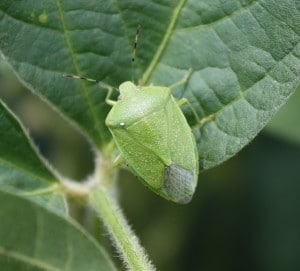
Stink bugs … We’ve been seeing more than the usual number of stink bugs in cotton and soybean for this time of year. These are mostly adult green stink bugs. I’m not very concerned about them until pods or bolls are present. I wouldn’t make a special trip to take them out unless pods or bolls are present. If you are spraying for plant bugs in cotton that is about to bloom, I’m not opposed to some proactive management. This may be a place where Orthene/Acephate or a pyrethroid insecticide is an option, although I usually try to wait until bloom before using those products. Neither Diamond or Transform are going to be great on stink bugs (similar for imidacloprid or Centric). Diamond will not kill adults, which is mostly what stink bugs you will find in cotton during early bloom. Many of the adult stink bugs have had the eggs of a parasitic tachinid fly on their backs (pictured). Maybe that will help hold populations down as we go later into the season.
- The threshold for stink bugs in soybean is an average of 9 stink bugs per 25 sweeps from R1-R6. I don’t expect those levels now except in some ultra-early fields that are acting as a trap crop.
- In cotton, once blooming begins, the threshold is one stink bug per drop cloth or 5 per 100 sweeps. Essentially, you count them as equivalent to 3 tarnished plant bugs when making a treatment decision. You can also base treatment off of boll damage ratings, where treatment is recommended when 20% or more of thumb-sized bolls show internal signs of damage (lint staining, warts on the interior boll walls).
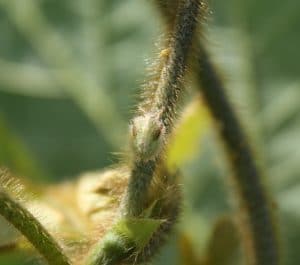
Kudzu bugs … You can expect to start finding more adults on soybean. After starting on kudzu, fresh adults are now migrating into soybean. They will pick on fields that are in the R1-R3 growth stages. I’m not expecting huge issues because we’ve had a lot of help from a fungus (Beauveria bassiana) keeping populations in check during the last two years. However, the warm winter favored successful overwintering, and you can’t always rely on Mother Nature. Below are a couple of management reminders.
- Don’t spray too early! It takes time and relatively high numbers before kudzu bugs cause damage. It is almost always better to wait until nymphs are established before pulling the trigger.
- The generally recommended threshold is to spray when you catch 1 immature kudzu bug per sweep (25/25 sweeps). By the time you start catching immatures, the adult migration is mostly over, and one application usually does the trick.
- Most pyrethroid insecticides work pretty well for controlling kudzu bugs. An exception is the cyfluthrin products like Baythroid XL and Tombstone. Bifenthrin (Brigade, Sniper, Tundra, Fanfare, etc.) is the pick of the litter at 5-6 oz/acre.
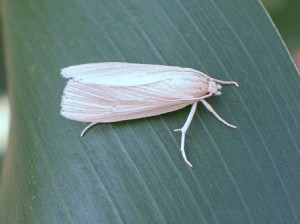
Southwestern corn borer … For those with non-Bt corn, the second generation moth flight is beginning. It usually takes another 7-10 days before signs of infestations are found in the field. Indeed, treatment for the second generation is recommended 7-10 days after moth traps capture 100 or more moths per week. If treatment is needed, recommended insecticides are listed at http://utcrops.com/cotton/cotton_insects/pubs/PB1768-Corn.pdf. I generally prefer Besiege, Prevathon, or Intrepid in tasseling corn because they provide longer residual and are less like to wash off.
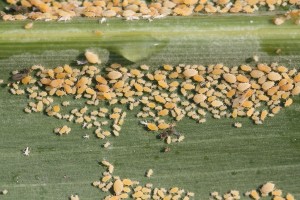
Sugarcane aphids … I’ve not received any phone calls, but I have seen a few sugarcane aphids on Johnsongrass. It’s time to start regularly checking sorghum or sweet sorghum fields. Remember, this can be a devastating pest if not managed appropriately. A couple of reminders and tips are provided below.
- This is one pest where edge scouting works well. If you can’t find sugarcane aphids on the edge of a field, then you don’t have a problem. Look for colonies on the undersides of leaves and the accumulation of the shiny honeydew.
- Identify the pest correctly. Sugarcane aphids are yellow, sometimes nearly white, and often occur on very large numbers on the undersides of leaves. Corn leaf aphid is usually of little concern. It is green in color and found in the whorls of plants, also sometime in large numbers. More Information
- In Tennessee, Sivanto Prime is the only labeled and effective insecticide. It’s the best product for sugarcane aphids. I’ve had excellent results at 4 oz/acre. The product is available in sweet sorghum under a Section 18, which means you need the Section 18 label in hand when making an application. More information
- In grain sorghum, treat when sugarcane aphids are present on 30 percent or more of plants and occasional leaves have 100 or more aphids present. Treatment should also be considered if honeydew is present in multiple spots throughout the field and aphid populations are increasing. More aggression is probably warranted for sorghum grown for molasses (sweet sorghum) because of the high value of this crop.

